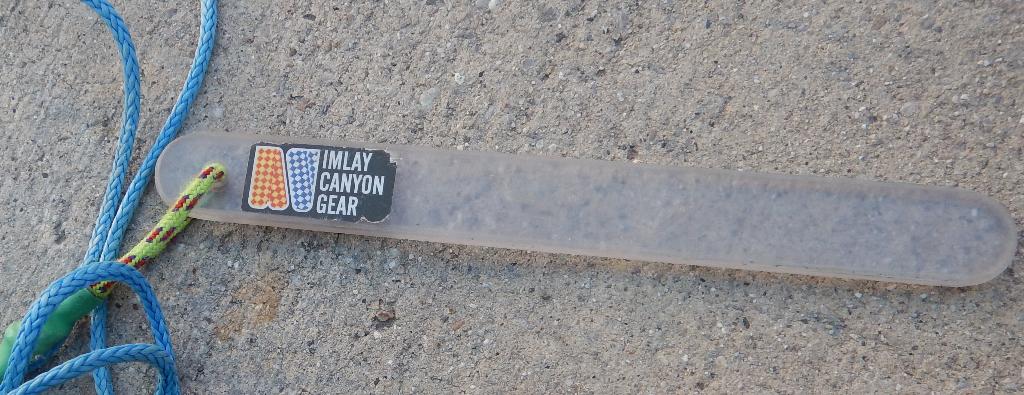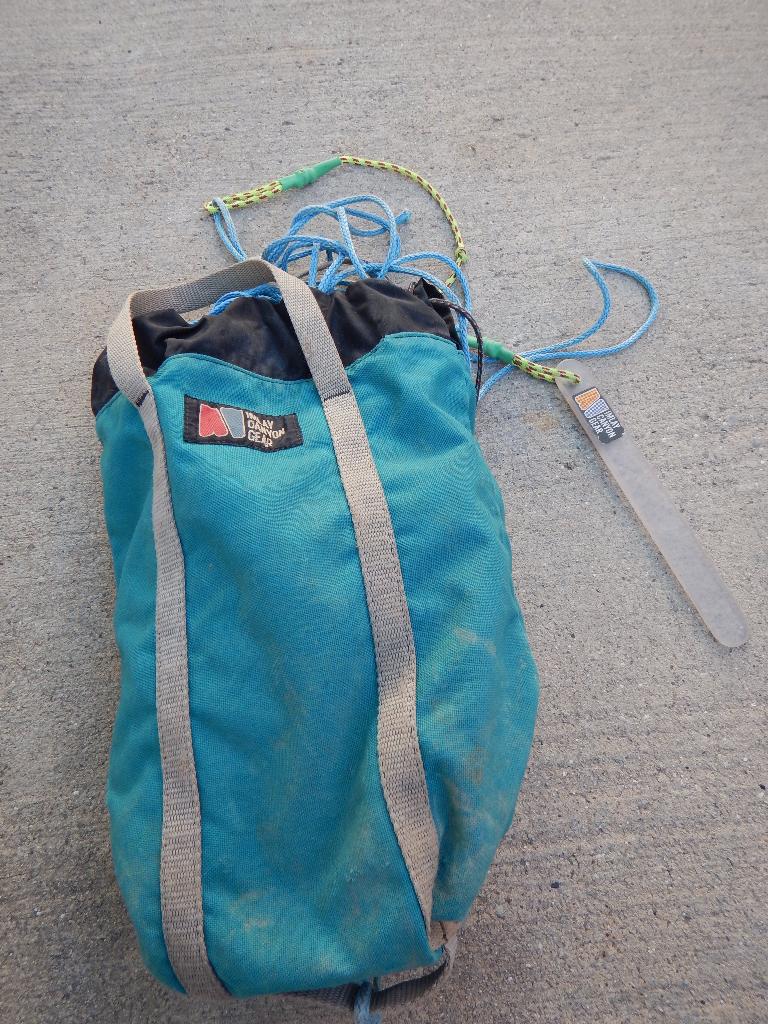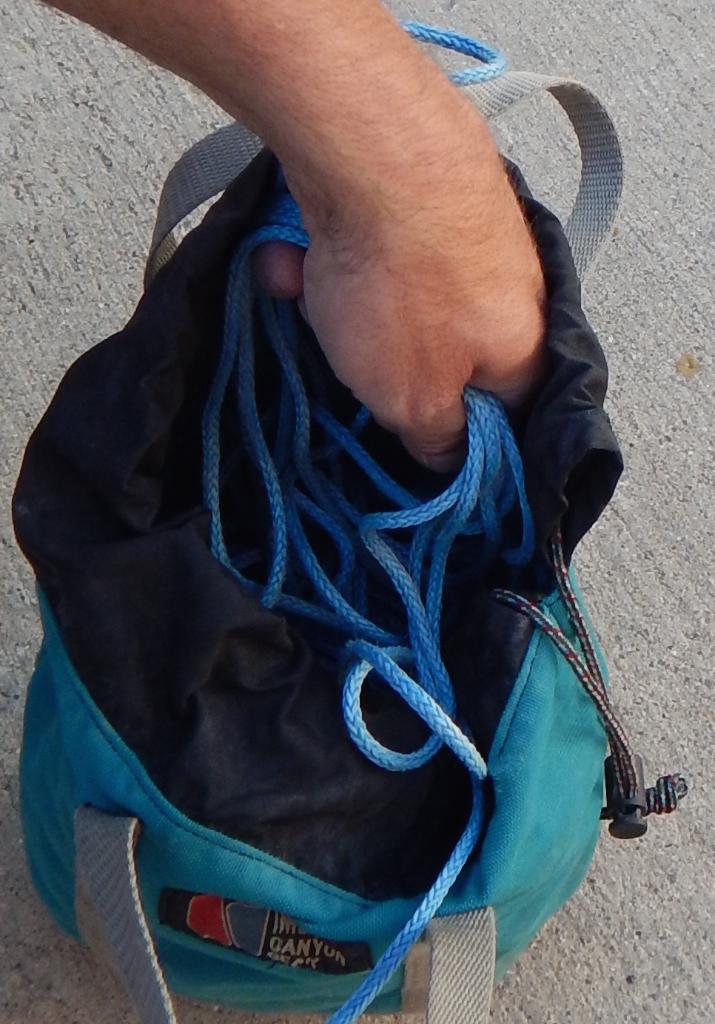Fiddlestick
I was in Zion this summer when a group behind us in Deadeye Dick caught up and was critiquing our use of the Fiddlestick. His point was "my friend ***** says it is way overused .. No point in using it here when there is an anchor in place .." His comments and overall attitude toward the Fiddlestick inspired me to write a review. I feel this clever little tool is misunderstood by many. (particular the arm chair canyoneer crowd that don't actually get out and use new fangled tools)
What is it?

The Fiddlestick is a simple piece of Lexan plastic with a hole drilled in one end. The spec page lists its weight at 2 ounces, which I can't disagree with. In conjunction with a Stone (Stein) knot, it allows for easy retrieval of a rope in many situations and is incredibly light weight.
In addition to the fiddlestick, you will need a pull cord. My current preference is 1/8"Amsteel Blue, which has a minimum strength of 2300 pounds and weighs in at 0.5 pounds per 100 feet. More on Amsteel at the bottom of this review.
I have a potshot that has my Fiddlestick and 330 feet of Amsteel Blue. Total weight is probably about 2 pounds.

How does it work?
See Tom's tech tips for how to set it up: http://www.canyoneeringusa.com/techtips/fiddlestick/
Review
I was a very slow adopter of the Fiddlestick. I got one, but it seemed a bit too good to be true, and too simple. Over time, however, it has become the go to item that comes along on every trip. Once I used it, understood how it worked, and when it was appropriate my eyes were opened and I'll never go back.
The Good
- It is light! I often do canyons solo or in a group of 2, where weight matters. Bringing the fiddlestick along can save me the weight of a pull cord or heavier second rope and makes for a much faster and lighter day.
- Once down the rappel, the work of coiling the rope and pull cord is split equally in half. I only need to bag exactly how much rope was used. Once you use it a few times, you'll be frustrated doing it any other way. One person bags the rope and one bags the pull cord, easy and fast to setup for a rappel and bag the rope after!
- It reduces greatly (or eliminates) rope grooves. This is what sold me on it. With the fiddlestick, generally only a couple of feet of rope pull over the lip of the rappel, making for easier pulls and almost eliminating the chance of creating rope grooves.
- Setup is simple, and easy to visually verify.
The Bad
- Care needs to be taken when setting it up so it can't push against the rock and self release. Sometimes this can take some creativity.
- In some cases, it could get caught in crevices when pulled. I have never had an issue with this, but be sure the pull path is clear.
- I personally wouldn't want to jug or try and mount a rescue on a rope that was solely anchored by the fiddlestick. To much jostling runs the risk of release.
- Though it seems like common sense, this is NOT A TOOL TO BE USED IN FLOWING WATER CANYONS!
Bottom Line:
I love it and have used mine on likely over a 100 rappels by now, up to about 240'. Being a nervous nelly, I have a couple of caveats:
As mentioned above, it needs to be set so it can't push out on the rock while rappelling. To accomplish this, I have in one extreme case rappelled double strand down 10 feet or so to a good ledge, then rigged the fiddlestick there so it was in a better free space orientation. This is where creativity and skill come in. If you can find a way to safely rig it, it works great.
In a group setting, I yard out 10 or so feet of rope, do an eight on a bight, and have people rappel off that as the anchor while I rig the Fiddlestick for the last person down. This insures if the person rappelling has a problem and needs assistance or to ascend, the rope is well fixed. In groups of more than two, only the last person (or two) uses the fiddlestick. This is my personal quirk, many have all members of the group rap of the fiddlestick. If doing that, have a backup plan if the person needs assistance while on rope.
On a related note: Amsteel Blue.. Greatest thing since sliced bread, or tangled monster?
Amsteel Blue is amazingly strong and amazingly light. It works best with the fiddlestick, and would be painful to try and use as a pull cord without using the fiddlestick. Highly recommended in conjunction with a Fiddlestick, but be aware, until you figure out a good system for coiling it, you may be dealing with a tangled mess more than you would like.
My easy approach to coiling:
I take 12-15 loops in my hand. Each loop is maybe about 12 inches.

Put it in a potshot.

Repeat until fully bagged. That is it! Easy-peasy.
Using this method, I generally have zero major tangles, and sometimes one or two minor ones that shake out easily. Of course tie each end to the potshot.
Beware!
It is small diameter. Be careful about abrasion. This is one of the reasons it would not work well as a non-Fiddlestick pull cord. It would abrade and cut after just a few uses.
After it is dropped, have someone pull it away from the rope. On 2 occasions I have had it tangle up in the rope on the way down to the point it was almost a hopeless tangled mess. Not fun to deal with on rappel! If someone CAREFULLY holds it out of the line of rappel, it is easy to avoid the tangle.
